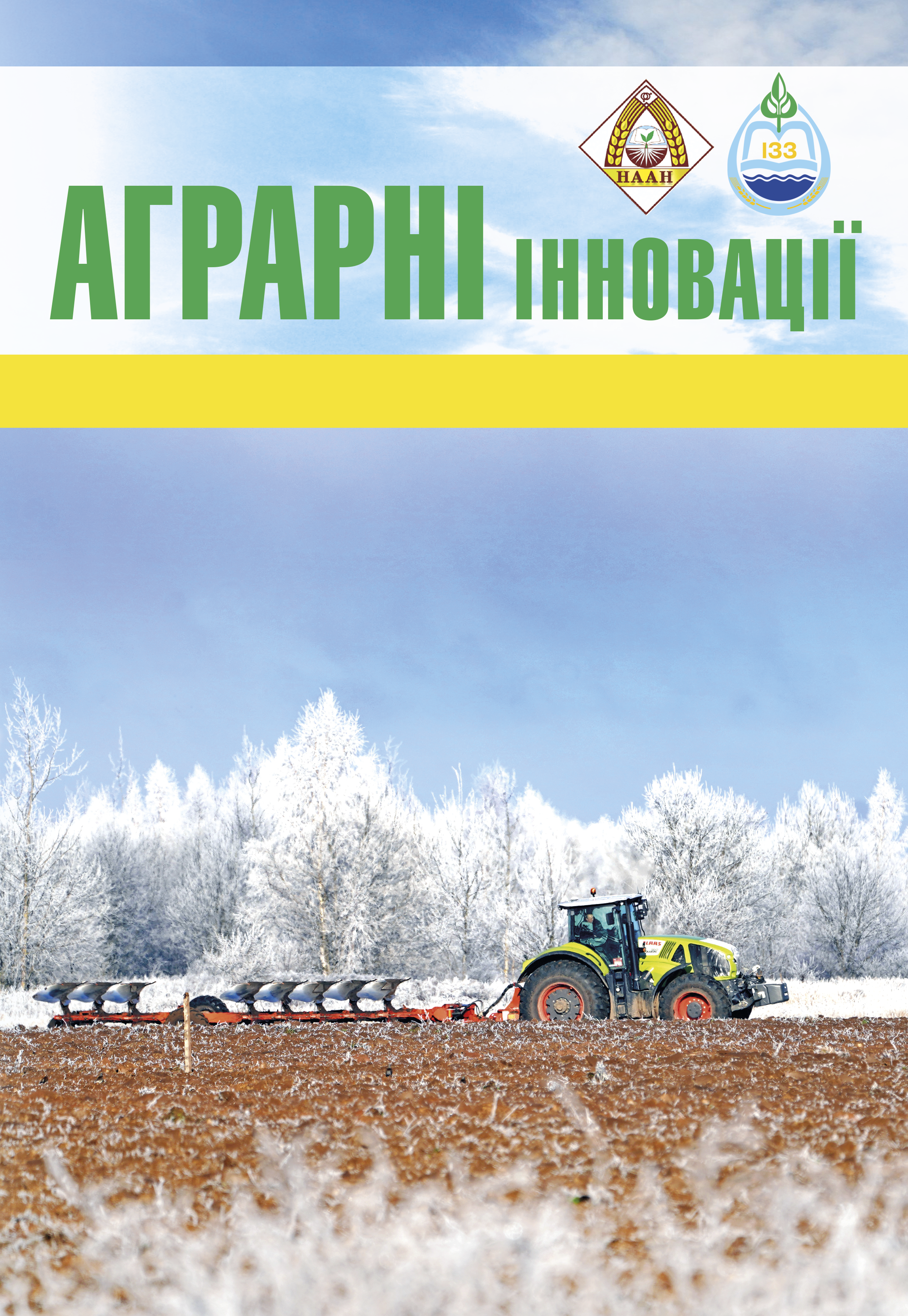Features of Lavandula angustifolia some varieties reproduction in the conditions of the Ukraine Southern Steppe
Abstract
Purpose. The purpose of the research is to select effective methods of reproduction of narrow-leaved lavender in accordance with the biological characteristics of one or another variety in the conditions of the Southern Steppe. Methods. The experimental part of the work was carried out on the basis of the State Enterprise “Experimental Farm “Novokakhovske” ICSA NAAS. The chernozem soils are slightly loamy with a humus layer thickness of 76 cm and a humus content in the arable layer of 1.33%. Years of research are 2019-2021. The research material was 6 varieties of Lavandula angustifolia from the collection of SE “Experimental Farm “Novokakhovske”. Varieties were propagated vegetatively and by seeds. During vegetative propagation by lignified cuttings the stimulator of rhizogenesis “Kornevin” was used for better rooting. 100 aligned cuttings of each variety were selected. The cuttings were dusted with the drug and planted in cold open greenhouses. By seed propagation 100 pieces of seeds of each variety were sown in 3-fold repetition in 3 variants in seasonal film greenhouses, cold open greenhouses and under agrofibre. As the soil dried irrigation was carried out. Results: When propagating 6 varieties of lavender vegetatively (by cuttings of lignified shoots), the share of rooted cuttings ranged from 13 to 83% over three years. The maximum indicators of cuttings rooting were noted by ‘Syneva Nadiі’ variety. Varieties ‘Victoria’, ‘Pink Flamingo’, ‘Zmiyuchka’ had low rooting rates from 13 to 24%. In order to select an effective method of reproduction of 6 varieties of lavender a study was carried out on reproduction by the seed method. Soil germination of seeds ranged from 43 to 70%. The best results were obtained in all varieties when sowing seeds in a seasonal greenhouse and under agrofibre. In these options, seedlings are friendlier than when sowing seeds in cold greenhouses. The highest indicators of soil germination were obtained by ‘Lydiya’, ‘Victoria’ and ‘Bereginya’ varieties. The lowest indicators of soil germination were obtained by ‘Pink Flamingo’ variety. According to the phenological observations of the seedlings, it was established that no atypical plants were found in the plantings of ‘Victoria’, ‘Lydia’, ‘Syneva Nadiі’ and ‘Bereginya’ varieties over the years of research, or they were within the norm (1-2 plants). And for ‘Pink Flamingo’ variety it was established that 20% of plants had non-typical morphological features. Conclusions: It has been established that in the conditions of the Kherson region lavender varieties ‘Lidia’, ‘Sineva Nadiі’ and ‘Bereginya’ can be propagated both vegetatively and by seed (sowing before winter). Varieties ‘Victoria’ and ‘Zmiyuchka’ are best propagated by seed. The ‘Pink Flamingo’ variety should be propagated vegetatively, regardless of the low rate of grafting of cuttings, as a significant share of non-typical plants (20%) was observed with the seed method of propagation.
References
2. Вожегова Р. А., Лиховид П. В., Біляєва І. М., Бойценюк Х. І. Сортовий склад ефіроолійних культур, придатних для вирощування на півдні України. Аграрні інновації. Херсон, 2021. Вип. 9. С. 57-60. https://doi.org/10.32848/agrar.innov.2021.9.9.
3. Дудченко В. В., Стеценко І. І. Продуктивність лавандину та економічна ефективність його вирощування за різних елементів технології. Наукові доповіді НУБіП України. 2023. № 4/104. http://dx.doi.org/10.31548/dopovidi4(104).2023.004
4. Călin Jianu, Georgeta Pop, Alexandra T. Gruia, Florin George Horhat. Сhemical composition and antimicrobial activity of essential oils of lavender (Lavandula angustifolia) and lavandin (lavandula x intermedia) grown in Western Romania. International Journal of Agriculture & Biology. 2013. № 15. Рр. 772-776.
5. Katarzyna Pokajewicz et al. Chemical Composition of the Essential Oil of the New Cultivars of Lavandula angustifolia Mill. Bred in Ukraine. Molecules. 2021. № 26(18). Р. 5681. https:// doi.org/10.3390/molecules26185681
6. Pokajewicz K., Białoń M., Svydenko L., Hudz N., Balwierz R., Marciniak D., Wieczorek P. P. Comparative evaluation of the essential oil of the new ukrainian lavandula angustifolia and lavandula x intermedia cultivars grown on the same plots. Molecules. 2022. № 27(7). https://doi:10.3390/molecules27072152
7. Directorate Agricultural Information Services, Department of Agriculture, Forestry and Fisheries, Pretoria, Republic of South Africa. A report on Essential oil crops: Production guidelines for lavender. 2009. Accessed 13.08.2018. http://www.nda.agric.za/docs/brochures/essoilslavender.pdf
8. Ileana Miclea, Raluca Chifor. Germination, in vitro Propagation and Acclimatization in Lavandula Angustifolia. Bulletin UASVM Animal Science and Biotechnologies. 2018. № 75(2). DOI:10.15835/buasvmcn-asb:2018.0017
9. Agnieszka Dobrowolska, Agnieszka Zawadzińska. The Influence of Stratification on Seedling Emergence and Growth of Narrow-Leaved Lavender and its Cultivars. International Journal of Plant & Soil Science 2014. № 3(8):948-958. Article no. IJPSS.2014.8.002
10. Рудник-Іващенко О. І., Кременчук Р. І. Біологічні особливості рослин лаванди за насіннєвого способу розмноження у Лісостеповій зоні України. Наукові доповіді НУБіП України. 2018. № 4 (74). С. 1-14.
11. Pryvedenіuk N. et al. Influence of mineral fertilizers and planting density on the growth, development and yield of narrow-leaved lavender (Lavandula angustifolia Mill). Agriculture and Forestry. 2023. Vol. 69. No. 2. P. 165-180. https://doi.org/10.17707/AgricultForest.69.2.13
12. Юрченко С. О., Баган А. В. Вплив стимуляторів росту на укорінення лаванди вузьколистої для садово-паркового вирощування. Аграрні інновації. Одеса, 2022. № 15. С. 73-77. https://doi.org/10.32848/agrar.innov.2022.15.11
13. Манушкіна Т. М. Фізіологічні особливості розвитку ізольованих меристем лаванди в культурі in vitro. Таврійський науковий вісник. 2012. Вип. 81. С. 108-115.
14. Colţun M. Step-by-step creation of a lavender plantation. Journal of botany. 2016. Vol. VIII, no. 2. P. 76-80.
15. Свиденко Л. В., Глущенко Л. А., Вергун О. М., Гудзь Н. І., Марковська О. Є. Оцінка впливу погодних умов на господарсько-цінні ознаки Lavandula angustifolia L. в умовах Херсонської області. Агроекологічний журнал. 2022. № 3. С. 84-93. DOI: https://doi.org/10.33730/2077-4893.3.2022.266413






